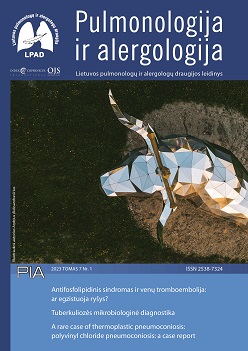ANALYSIS OF CLINICAL DATA OF PATIENTS TREATED FOR EXTRAPULMONARY TUBERCULOSIS AT THE HOSPITAL OF LITHUANIAN UNIVERSITY OF HEALTH SCIENCES KAUNO KLINIKOS AT THE ROMAINIAI TUBERCULOSIS HOSPITAL
Abstract
Objective. To evaluate the clinical data of patients treated for extrapulmonary tuberculosis (EPTB) at the Hospital of Lithuanian University of Health Sciences Kauno clinics at the Romainiai Tuberculosis Hospital. Methods. The study analyzed patients who were treated in the extrapulmonary tuberculosis department of the Romani Tuberculosis Hospital in 2020–2021 years medical histories – 70 cases of illness. Medical histories of patients treated in an inpatient setting were selected using the electronic health information system available at the Hospital of Lithuanian University of Health Science Kauno clinics. During the study, the patients’ medical histories were analyzed, and data collected: age, gender, diagnosis, concomitant diseases, symptoms of the disease, duration of symptoms, contact with a person suffering from tuberculosis, bad habits. Results. Seventy patients with EPTB were analyzed, 33 men and 37 women, aged 20–91 age. Most patients were treated for tuberculosis (TB) in the kidneys 27 (38.6 %) and spine 27 (38.6 %). Renal TB was more common among women 19 (70.4 %) than men 8 (29.6 %). Men 17 (63.0 %) had spinal TB more often than women 10 (37.0 %). 84 % of patients did not know that they had contact with a TB patient. Co-morbidities were identified in 87.1 % of patients. A tuberculin sample was performed in 64.3 % of patients, and 72 % were found to be positive. The diagnosis of EPTB was mostly determined by imaging methods (51.9 %), histologically 2.9 %, bacteriologically 18.6 %, clinically 5.7 %. Anti-tuberculosis treatment was prescribed to all patients, invasive treatment methods (ureteral stenting and other surgical interventions) were used in 11.4 % of patients. 95.7 % of patients recovered. Conclusions. Most patients were treated for renal and spinal TB. Renal TB was more common in women than men, spinal TB was more common in men. The diagnosis of EPTB was usually determined by imaging methods. All patients received anti-tuberculosis treatment, and few underwent invasive treatment.


